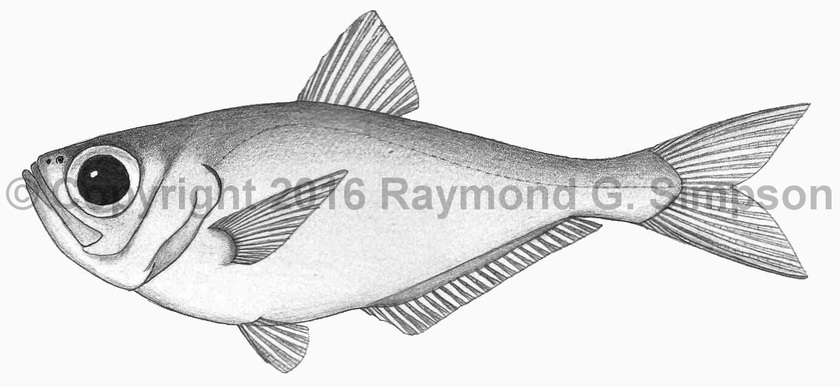
Common Name
Shortfin Sweeper
Year Described
Bean, 1885
Identification
Dorsal Fin: IV-VI (mostly IV), 8-10
Anal Fin: III, 22-26
Pectoral Fin: 15-18
Pelvic Fin: I, 5
Lateral Line Scales: 48-61
Scale under lateral line: 8-9
Circumpeduncular scales: 13
Gill Rakers: 24 total
Vertebrae: 25 (10 + 15)
Body very deep and compressed. Eye very large. Mouth oblique and terminal; reaching to middle of orbit. Teeth present in both jaws, on palatine, and on vomer. Dorsal profile slightly arched. Body profile at anal fin very steep. Caudal peduncle fairly long with a forked tail. Dorsal fin single and short-based. Pelvic fin very small. Pectoral fin with oblique base and pointed. Anal fin low and very long-based (over half of SL). Body and most of head fully scaled. Lateral line steeply sloped on the anterior end.
Color
Body silvery to pale translucent with bright green to yellowish sheen on the midbody and a dusky yellowish back. No dark band on anal fin base.
Size
Maximum size to 10cm SL
Habitat
Found mostly on shallow reefs up to 30m depth. Forms large schools near recesses.
Range
Scattered records in the Caribbean Sea from the Bahamas to Colombia. Also Bermuda.
References
Mooi, R. D. 2002. Pempheridae (pp. 1660-1661). In: Carpenter. 2002. The living marine resources of the Western Central Atlantic. Vol. 3: Bony fishes part 2 (Opistognathidae to Molidae). FAO Species Identification Guides for Fisheries Purposes. American Society of Ichthyologists and Herpetologists Special Publication No. 5. FAO of the U.N., Rome.
Pinheiro H.T., Bernardi G., and L. A. Rocha. 2016. Pempheris gasparinii, a new species of sweeper fish from Trindade Island, southwestern Atlantic (Teleostei, Pempheridae). ZooKeys 561: 105-115.
Other Notes
The related Pemperis gasparinii from Trindade Island, Brazil is cited as differing by having a higher lateral line scale count (51-54 vs. 47-49), scales below lateral line (10-11 vs 9), scales around caudal peduncle (11-12 vs 13), and caudal peduncle length (2.7-3.3 vs. 3.5-4.0 times in HL). It is also strongly disjunct in distribution and is genetically divergent from P. poeyi (Pinheiro et al., 2016). As the lateral line counts in other sources range from 48-61, this species should be investigated over the rest of its range to determine the limits of morphological variability in these mersitic values.